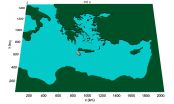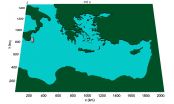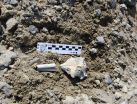(Press-News.org) A team of European researchers have developed a model to simulate the impact of tsunamis generated by earthquakes and applied it to the Eastern Mediterranean. The results show how tsunami waves could hit and inundate coastal areas in southern Italy and Greece. The study is published today (27 August) in Ocean Science, an open access journal of the European Geosciences Union (EGU).
Though not as frequent as in the Pacific and Indian oceans, tsunamis also occur in the Mediterranean, mainly due to earthquakes generated when the African plate slides underneath the Eurasian plate. About 10% of all tsunamis worldwide happen in the Mediterranean, with on average, one large tsunami happening in the region once a century. The risk to coastal areas is high because of the high population density in the area - some 130 million people live along the sea's coastline. Moreover, tsunami waves in the Mediterranean need to travel only a very short distance before hitting the coast, reaching it with little advance warning. The new study shows the extent of flooding in selected areas along the coasts of southern Italy and Greece, if hit by large tsunamis in the region, and could help local authorities identify vulnerable areas.
"The main gap in relevant knowledge in tsunami modelling is what happens when tsunami waves approach the nearshore and run inland," says Achilleas Samaras, the lead author of the study and a researcher at the University of Bologna in Italy. The nearshore is the zone where waves transform - becoming steeper and changing their propagation direction - as they propagate over shallow water close to the shore. "We wanted to find out how coastal areas would be affected by tsunamis in a region that is not only the most active in the Mediterranean in terms of seismicity and tectonic movements, but has also experienced numerous tsunami events in the past."
The team developed a computer model to represent how tsunamis in the Mediterranean could form, propagate and hit the coast, using information about the seafloor depth, shoreline and topography. "We simulate tsunami generation by introducing earthquake-generated displacements at either the sea bed or the surface," explains Samaras. "The model then simulates how these disturbances - the tsunami waves - propagate and are transformed as they reach the nearshore and inundate coastal areas."
As detailed in the Ocean Science study, the team applied their model to tsunamis generated by earthquakes of approximately M7.0 magnitude off the coasts of eastern Sicily and southern Crete. Results show that, in both cases, the tsunamis would inundate the low-lying coastal areas up to approximately 5 metres above sea level. The effects would be more severe for Crete where some 3.5 square kilometres of land would be under water.
"Due to the complexity of the studied phenomena, one should not arbitrarily extend the validity of the presented results by assuming that a tsunami with a magnitude at generation five times larger, for example, would result in an inundation area five times larger," cautions Samaras. "It is reasonable, however, to consider such results as indicative of how different areas in each region would be affected by larger events."
"Although the simulated earthquake-induced tsunamis are not small, there has been a recorded history of significantly larger events, in terms of earthquake magnitude and mainshock areas, taking place in the region," says Samaras. For example, a clustering of earthquakes, the largest with magnitude between 8.0 and 8.5, hit off the coast of Crete in 365 AD. The resulting tsunami destroyed ancient cities in Greece, Italy and Egypt, killing some 5000 people in Alexandria alone. More recently, an earthquake of magnitude of about 7.0 hit the Messina region in Italy in 1908, causing a tsunami that killed thousands, with observed waves locally exceeding 10 metres in height.
The team sees the results as a starting point for a more detailed assessment of coastal flooding risk and mitigation along the coasts of the Eastern Mediterranean. "Our simulations could be used to help public authorities and policy makers create a comprehensive database of tsunami scenarios in the Mediterranean, identify vulnerable coastal regions for each scenario, and properly plan their defence."
INFORMATION:
Please mention the name of the publication (Ocean Science) if reporting on this story and, if reporting online, include a link to the paper (TBA) or to the journal website (http://www.ocean-science.net).
For over a century, nitroglycerin has been used medically - particularly in the treatment of angina, or chest pain. It is a safe, cheap and effective treatment. Now, according to the latest study in ecancermedicalscience, researchers find that nitroglycerin is the latest in a series of medicines that could be repurposed to treat cancer.
The Repurposing Drugs in Oncology (ReDO) project, an international collaboration between the Anticancer Fund, Belgium, and US based GlobalCures, finds that existing and widely-used non-cancer drugs may represent a relatively untapped source ...
Physicists at the University of Basel succeed in synthesizing boron-doped graphene nanoribbons and characterizing their structural, electronic and chemical properties. The modified material could potentially be used as a sensor for the ecologically damaging nitrogen oxides, scientists report in the latest issue of Nature Communications.
Graphene is one of the most promising materials for improving electronic devices. The two-dimensional carbon sheet exhibits high electron mobility and accordingly has excellent conductivity. Other than usual semiconductors, the material ...
When they're not being the stars of various animated movies, penguins are playing an important role in evolutionary studies. Penguins are unique among modern birds in that they 'fly' through the water. Although flightless in air, penguins have a number of adaptations which allow them glide effortlessly through the water. And some of these adaptations are in an unlikely part of their anatomy - their brains. Recent finds of fossil penguins from 35 million year old sediments in Antarctica have begun to shed light on the changes in penguin brains that accompanied their ...
More than a cause of a simple infection, viruses are often involved in the development of serious diseases. Such is the case with liver cancer, which often develops in an organ that has been weakened by hepatitis B or C virus. Researchers at Inserm, the Paris Public Hospitals (AP-HP), Paris Descartes University, Paris 13 University (USPC), and Paris Diderot University have just identified the role of a new virus, hitherto unsuspected, in the occurrence of a rare type of liver cancer.
This study, based on follow-up and observation of 193 patients, is published in the 24 ...
Consumers aren't embracing electric cars and trucks, partly due to the dearth of charging stations required to keep them moving. Even the conservation-minded are hesitant to go electric in some states because, studies show, if fossil fuels generate the electricity, the car is no greener than one powered with an efficient gasoline.
Charging cars by solar cell would appear to be the answer. But most cells fail to meet the power requirements needed to directly charge lithium-ion batteries used in today's all-electric and plug-in hybrid electric vehicles.
Researchers at ...
New research published in Acta Obstetricia et Gynecologica Scandinavica, a journal of the Nordic Federation of Societies of Obstetrics and Gynecology, found that pregnant women in Sweden had inadequate levels of iodine in their diets. Proper iodine nutrition is necessary for neurological development of the fetus.
Iodine is an element that is involved in the production of thyroid hormones. Pregnant and breastfeeding women need about 50% more iodine in the diets, and WHO recommends a total daily iodine intake of 250 μg/d for pregnant and lactating women. Medical evidence ...
Probiotics show no benefit for preventing or eliminating gastrointestinal colonization with drug-resistant organisms in patients in the intensive care unit compared to standard care, according to new research published online today in Infection Control & Hospital Epidemiology, the journal of the Society for Healthcare Epidemiology of America.
"Our research suggests that probiotics do not help prevent gastrointestinal colonization with multidrug-resistant organisms in critically ill patients," said Jennie H. Kwon, DO, lead author of the study.
This prospective, randomized ...
August 27, 2015 - Do you have problems with dry eyes? If so, you're not alone--it's one of the most common reasons for patient visits to eye care professionals. Recent years have seen significant progress in management of patients with dry eyes, according to the September special issue of Optometry and Vision Science, official journal of the American Academy of Optometry. The journal is published by Wolters Kluwer.
"There has been a growing interest among clinicians and patients on treatment and management and origins of the signs and symptoms of dry eye," comments Anthony ...
This news release is available in French.
Not even close to every person who faces challenges or lives with severe depression commits suicide. Some people are more vulnerable than others.
A series of studies has shown that the way in which a person makes decisions is among the main factors that determines whether that person is protected from or vulnerable to suicide. High-risk decision-making was prevalent among many parents of individuals who committed suicide, which may serve to explain its apparent "inheritability".
Dr. Fabrice Jollant, Assistant Professor ...
While most primary care physicians responding to a survey taken in late 2014 and early 2015 expressed confidence in their ability to identify potential cases of Ebola and communicate Ebola risks to their patients, only 50 to 70 percent of them gave answers that fit with CDC guidelines when asked how they would care for hypothetical patients who might have been exposed to Ebola. In addition, those who were least likely to encounter an Ebola patient - based on their location and characteristics of their patients - were most likely to choose overly intense management of patients ...



